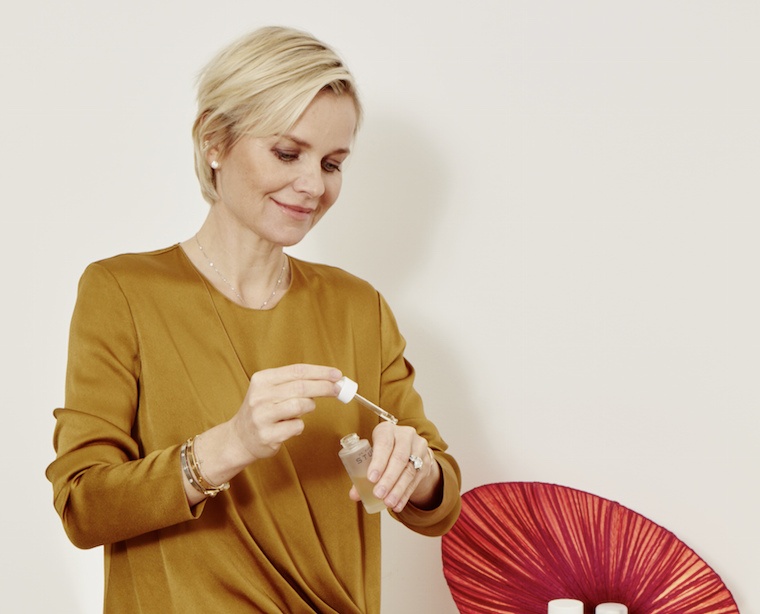The Key Ingredient in This Moisturizer Is Your Own Blood
As a writer who focuses on the intersection of wellness and beauty, I hear a lot about "beauty from the inside out," but the spin is usually supplements or a diet rich in superfoods. Slathering my own blood on my face for a clearer complexion, though? Not so much.
But, as it turns out, your blood contains healing ingredients that might help with a slew of issues, ranging from hyperpigmentation to eczema to acne. How's that for self-care?
Barbara Sturm, MD, an orthopedic doctor-turned-skin-care guru with an eponymous line beloved by radiant stars like Rosie Huntington-Whitely and Cher (her good pal) helped kick-start the whole frenzy. Her famous MC1 Blood Moisturizer (which clocks in at around $1,400 per jar) touts a key ingredient: plasma, which contains platelets and other white blood cells.
It turns out, your blood contains healing ingredients that might help with a slew of issues.
"Platelets contain high levels of growth factors, which are messengers that tell our aging skin cells to behave like young, healthy cells," says Joshua Zeichner, MD, a New York City-based dermatologist. "We harness the power of platelet-rich plasma for a variety of skin and hair issues, including fighting off aging and helping to regrow thinning hair."
He notes that this plasma (also known as PRP) can be applied topically, injected into the skin (à la the vampire facial made famous by Kim Kardashian) or the scalp. "In the skin, growth factors tell your collagen-producing cells to rev up their activity, which makes new collagen to strengthen the skin's foundation," says Dr. Zeichner. "Because these come from your own body, the growth factors are specifically active towards you."
In other words: Beauty really does start from within. Here's what you need to know.
Keep reading to learn more about Dr. Sturm's creation, the healing factors of your own blood, and what happened to my complexion when I tried it.

The story behind the blood cream
Dr. Sturm, barefoot in chic printed pants and a white T-shirt, explains the skin-boosting prowess of blood as she begins drawing mine within three minutes of meeting her at Georgia Louise Atlelier on New York City's Upper East Side. It doesn't hurt. I ask how many times she draws blood per day and she laughs, claiming it's too many to count.
"After about four to five hours [of incubating your blood], the concentration of healing factors in it is 147 times higher than before," Dr. Sturm tells me. "After extracting the healing factors from the blood cells, they are [reintroduced] to your skin [via the cream], and they go on to help activate its own repair mechanisms to rejuvenate, repair damage, and keep the skin heathy."
According to Dr. Sturm, blood is right up there with turmeric and moringa, in terms of anti-inflammatory powers. "Blood contains anti-inflammatory proteins, which fight inflammation that causes acne, clogged pores, and eczema—even aging," she says. So it allegedly works reparative magic. But how on earth did she come up with this idea?
"Blood contains anti-inflammatory proteins, which fight inflammation that causes acne, clogged pores, and eczema—even aging."
Dr. Sturm was part of the team that developed the Orthokine treatment for osteoarthritis and back pain. Later known as the “Kobe Procedure” after patient and basketball star Kobe Bryant, the Orthokine treatment is a therapy in which the patient’s own blood cells are used to produce proteins that reduce inflammation and stimulate the healing process. "This uses the MCX which consists of healing factors that are generated from the patient's own blood," she explains.

{{post.sponsorText}}
But during this time, she admits she also had issues with her own skin. So a light bulb went off—since the Kobe Procedure worked so well, why not apply that to your skin so it heals on a cellular level? "Cartilage and skin cells are of the same tissue family, so after seeing the effects of the body's own healing factors using cartilage tissue, I had the idea of mixing the proteins into a cream to use on myself," says Dr. Sturm.

The skin-boosting powers of blood
Blood, when applied topically, is a potent treatment that's "greatly tolerated because the substances used are derived from one's own body," explains Dr. Sturm (which is also why she doesn't recommend sharing the product). She adds that the proteins that are used also have growth factors that mimic those found naturally in the skin, which is why they work so seamlessly.
I pick up my MC1 the following day after Dr. Sturm incubates it. Then I skip home. When I apply the blood cream to my skin, which is actually thick, white, and scentless, I swear I see an immediate effect. My complexion is brighter, plump with moisture, and way more even than it was right before that. It seems too crazy to be true—much like vampires—but it is.
And the same thing happened when Dr. Sturm tried the self-concocted, blood-infused moisturizer on her own skin. "The outcome was so great that I started offering it to my patients that would come to my clinic," she says. "This got popular really fast."
My complexion is brighter, plump with moisture, and way more even than it was right before that.
So it's about as bespoke as you can get (not to mention spooky, if you're into the Halloween vibes). And, judging by how it's made my skin look over the past week and a half, consider me the number one fan of using my own blood for radiance. It's utterly—and eerily—amazing.
Other out-there things to do for a glow include getting a cryofacial or replacing your face wash with honey (both of which I've tried).
Loading More Posts...